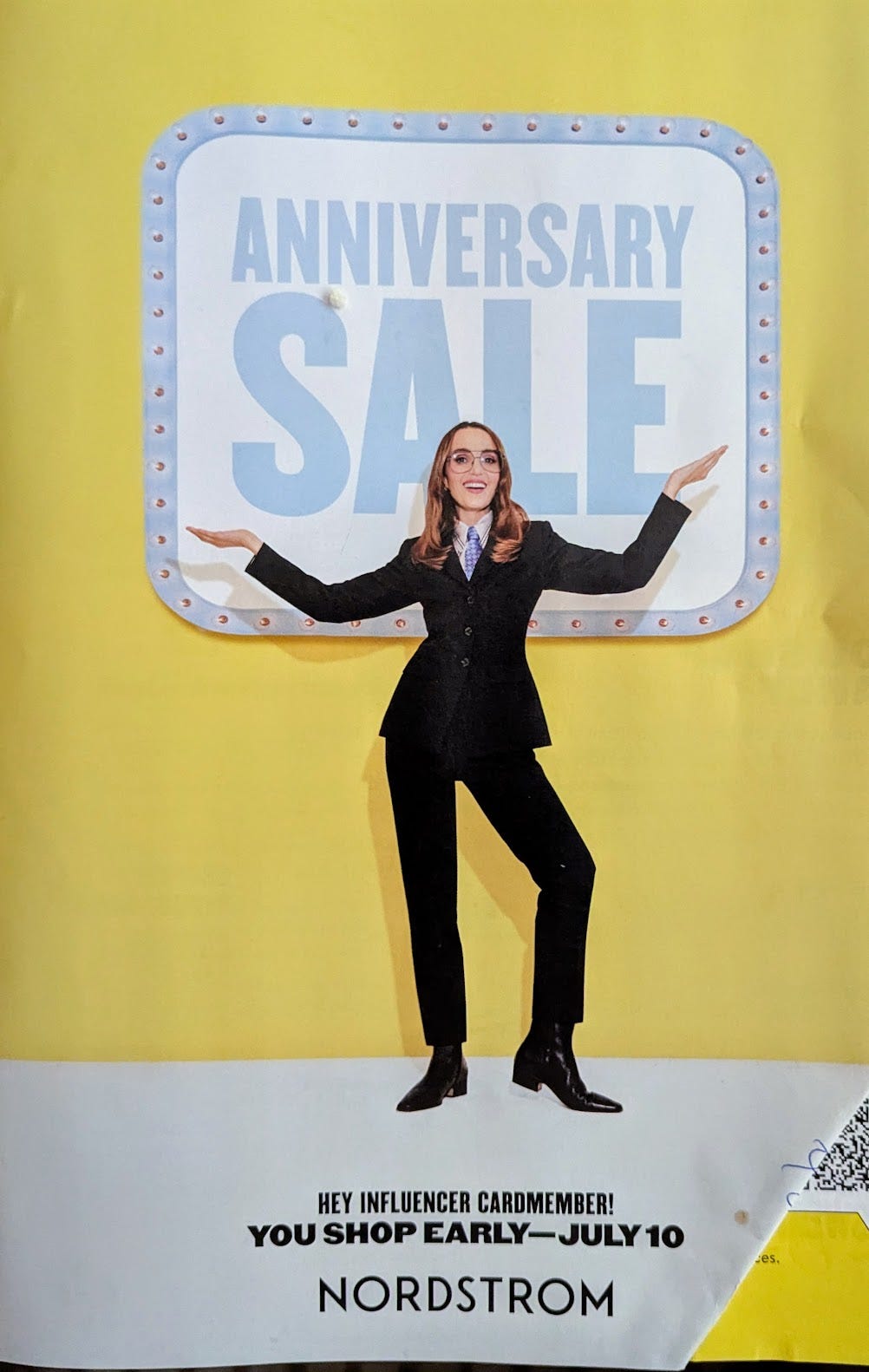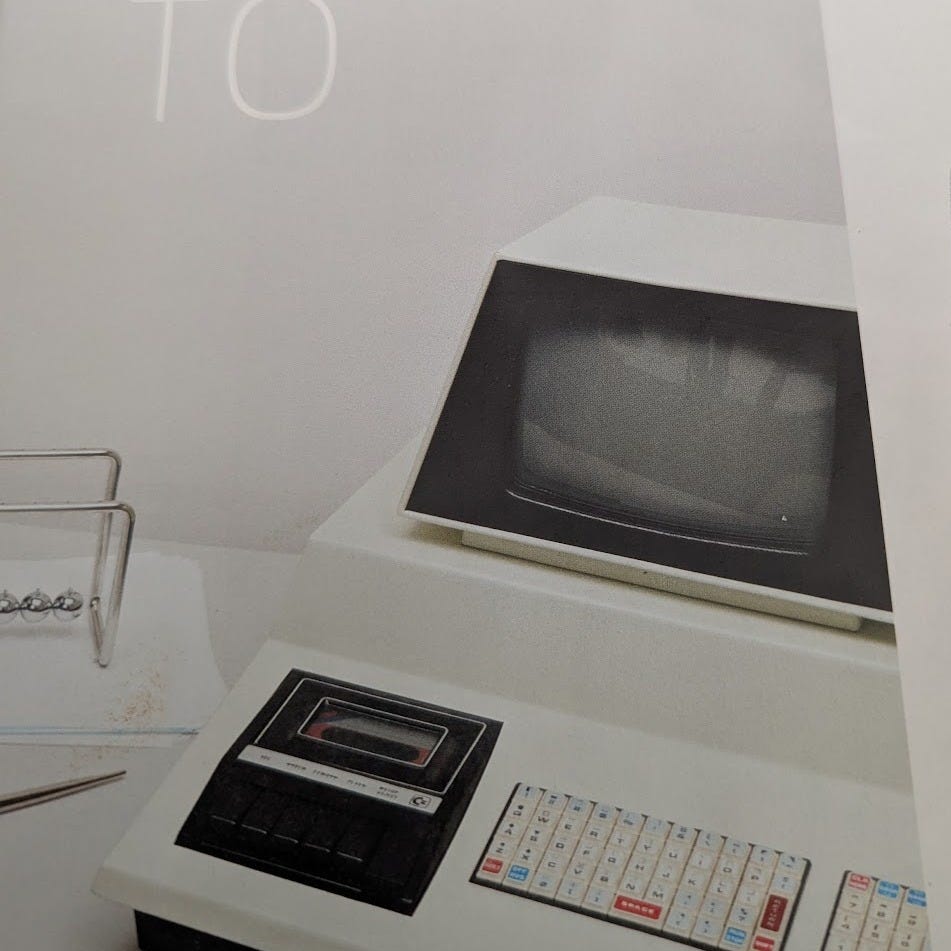Return to (oddly anachronistic) office with Nordstrom
The clothes are current. The technology is obsolete. Are we buying it?
Sometime in the early 1960s, when Nordstrom was still a regional Pacific Northwest retailer, the company introduced its Anniversary Sale, a July event notable for what it wasn’t. This was no everything-must-go price-slashing of past seasons’ merchandise. Instead, NAS — as fans refer to it — offered sizable discounts on new early-fall goods. The tradition continues to this day; despite frequent grumbling that the goods aren’t as good as they used to be, Seattle Met reported in 2021 that “[t]he anniversary sale boosts Nordstrom’s numbers to near-holiday levels during the notoriously slow days of summer.”
Because I’m a Nordstrom cardholder who spends (barely) enough each year to qualify for “Influencer” status1, I received the bright-yellow 112-page NAS catalog in my physical mailbox last week.

I flipped through the catalog and failed to find anything that might move my life in a positive direction. Then I flipped through again, paying attention not to merchandise and prices but rather to the art direction. This time I noticed something peculiar on several of the spreads.
Like this one.

Take a closer look. Not at the clothes — at the props.
On the left, spilling into the page gutter, is one of those pendulum toys — a “Newton’s cradle” — that used to be a desk-decor staple right alongside the stapler. Remember staplers?
And what’s that on the right? Why, it’s a Commodore PET 2001, the very bleeding edge of personal technology when it was introduced in 1977 — nearly half a century ago.
What a marvel it was. The Commodore PET featured (per Wikipedia) an all-in-one case that combined a MOS Technology 6502 microprocessor, Commodore BASIC in read-only memory, a keyboard, and a monochrome monitor. You know this one’s an early model because it also has a cassette deck in the lower left-hand corner. It retailed for US$795, the equivalent of $4,100 in 2024 dollars.
Why was it called the PET? Because Commodore’s VP of engineering, Andre Souson, had seen the Pet Rock — a short-lived gimmick introduced in 1975 at a San Francisco gift show — and declared that Commodore’s creation would be a “pet computer.” (PET was eventually backronymed to Personal Electronic Transactor.) The “2001” in the name “was chosen simply because that was familiar to the public via the film 2001 - A Space Odyssey, and so sounded suitably space-age.”2 Andre Souson, by the way, left Commodore shortly after his naming triumph; he went on to become an early employee of Apple Computer and the founder of Eurapple.
I’ve tried to figure out why an art director in 2025 would choose an obsolete computer as set decoration for a spread about contemporary business attire. Maybe the model’s pose is a clue: Has he been asleep since 1982, the year the Commodore PET was discontinued? Is he a gallerist in the Computer History Museum? Is he dreaming of a work life that predates AI?
Is it a nostalgic homage?
Or is it all just, you know, ironic?
The office ladies in the NAS catalog look more wide-awake than their male counterpart, but their props are as stuck in the 20th century as his is.
That object on the desk in the upper right-hand photo, which I’ve helpfully circled in red? It looks to me like a Motorola DynaTAC ET 1000 cordless phone. Everyone wanted one in 1992, the year it was introduced. I found one very much like it on eBay; asking price: $2,999. (“This phone has not been tested for functionality. Sold as is. No charger or accessories are included in this sale.”)
It’s as if an office-fashion spread in 1977 had featured a candlestick phone from the 1920s.

It would have been odd, to say the least. In the past, fashion wanted to represent the present, or even the future.
So what’s different now? I’ll hazard some guesses:
For the last five years, ever since Covid disrupted work patterns, we’ve become confused about what “returning to office” means. Clock-punching? Meetings? Flirting? Lunch?
Come to think of it, what is an office supposed to look like? Are file cabinets still a thing?
Because we’re no longer sure why offices exist or what they look like, we’re hazy on what “office wear” is. Can’t we just be comfy-casual all the time? As GQ put it last month, “For many [men], the very notion of building a separate, blander wardrobe specifically for the workplace seems somehow antiquated.”
Taking the place of actual, functional business attire is the business aesthetic: a performance of workwear that goes by various names, including corpcore, office siren (aka “business casual for hot girls”), and officecore. (For more on this sense of aesthetic see my February 2025 post; for more on the -core suffix, see my 2022 column for the Visual Thesaurus.) The Aesthetics Wiki, the bible for cultural micro-trends, breaks down the corporate aesthetic into sub-genres: cyberprep, boujee, Y2K futurism, and more.
Which brings us back to Nordstrom. Someone is still manufacturing blazers and tailored trousers. Your job is to sell them. How to make the clothes intelligible — and necessary, and even fun — to customers who have little memory of, or appetite for, office dress codes? Who think a workplace wardrobe is an “antiquated” notion?
One answer: Spoof the whole concept with retro, antiquated accessories. That computer, that phone, those mid-century-modern chairs: They’re not for working, they’re for cosplaying work. The photos wink at us, murmuring that all the world, including your office, is a stage set, and your clothes are just costumes.
Feel like shopping now? Forget about a trip to the mall: The local Nordstrom, at least where I live, shut down almost two years ago. Maybe those props in the photos are a salute to the past: to a time when department stores thrummed with life and our office machines were clunky but proudly, endearingly optimistic.
Don’t get too excited: Influencer is the lowest rung of the spending ladder. I have a long way to go before becoming an Ambassador, and can only dream about making it to Icon.
This tidbit comes from Nosher.net, a British website that has been cataloguing all sorts of stuff since 1999. Much of it is personal or quirky — “A History of Flint Knapping in Brandon, Suffolk” — but for weirdos like me there’s also “A history of the microcomputer industry in 300 adverts.”







This catalog seems to aim at the most nostalgic generation in American history, judging by under-35 consumers buying record amounts of "legacy" candy, streaming shows of yester-decades, and voting in unusual percentages for elderly political candidates. I'm even seeing unusual numbers of paper magazine startups by Gen-Zs--many of whom are buying charmingly ugly Early Modern furniture. Why not harken back to the 80s, minus the hair and shoulder pads?
Nice. I bet it never occurred to the art director that anyone actually used this equipment, especially the phone. Nobody talks on phones anymore.